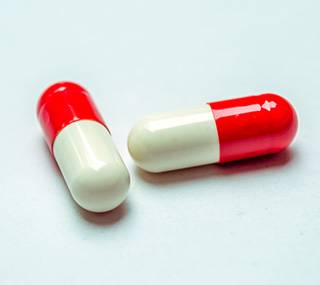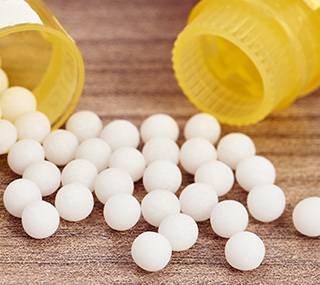Homoeopathy
Homoeopathy includes two types of medicines, those with a non-proprietary name and those with a brand name, as well as preparations derived from active substance(s) known as stocks. Like other medicines, homoeopathic medicines cannot be marketed without prior authorisation from ANSM, which guarantees their quality and safety and recognises their homoeopathic usage.
Homoeopathic preparations
What are homoeopathic preparations?
Homoeopathic preparations are prepared from substances, products or preparations called stocks, in accordance with a homoeopathic manufacturing procedure.A homoeopathic preparation is usually designated with the Latin name of the stock, followed by an indication of its degree of dilution and/or deconcentration, where applicable. (European Pharmacopoeia, No. 1038).
What are pharmacy-compounded homoeopathic preparations?
Pharmacy-compounded homoeopathic preparations are prepared in pharmacies based on a medical prescription. They are intended for a specified patient due to the lack of an appropriate and available authorised pharmaceutical product. They are prepared in accordance with Good Preparation Practice published by ANSM. They are defined in article L.5121-1 for the French Public Health Code (CSP).
Pharmacy-compounded homoeopathic preparations may consist of a single stock or of several stocks. Their preparation may be subcontracted to pharmaceutical sites authorised to manufacture medicines (Article R. 5125-33-4.-I of the French Public Health Code).
N.B.: pharmacy-compounded homoeopathic medicines are not authorised, if an ANSM-authorised homoeopathic medicine is available.
They are sold under their Latin scientific name. The labelling contains no therapeutic indications, dosage or package leaflet, in accordance with the principle that a stock may correspond to various symptoms or be prescribed for different conditions. In this way, healthcare professionals determine the indication of the medicine and its dosage according to the patient. These non-proprietary medicines are subject to registration granted by ANSM. They are available over the counter, or usually dispensed on medical prescription.
They include a therapeutic indication, a dosage, and are accompanied by a package leaflet. They are suitable for self-medication. These proprietary products are subject to a marketing authorisation (MA) granted by ANSM. They are available over the counter in the pharmaceutical circuit.
An appropriate dossier, accounting for the specificity of the homoeopathic medicine and generally traditional usage (Article R.5121-28-5), is submitted in support of the application.
Registration decisions may include, for each homeopathic stock, all the authorised dilutions and the various pharmaceutical forms authorised (granules, granules in a single-dose container, tablets, oral solutions in an ampoule, oral drop solutions, ointments and oral powder).
Like other medicines, homeopathic medicines cannot be marketed without prior authorisation from ANSM, which guarantees their quality and safety and recognises their homeopathic usage (traditional usage).
These authorisations (registrations and MAs) can be consulted in the registry of pharmaceutical products or the public medicines database.
Furthermore, all homoeopathic medicines with authorisations granted before 18 January 1994 (i.e. 1163 stocks) are being reassessed by ANSM.
The reassessment specifically focuses on aspects related to safety and quality based on an assessment of the risks associated with the composition of the starting material included in each stock. The non-clinical assessment allow to estimate the safety of the stock by defining a suitable dilution level that does not pose a risk to human health. Recognition of the homoeopathic tradition must also be justified. Following the assessment, a registration decision or marketing authorisation is granted based on the requirements of the current regulations.
As they are granted, ANSM publishes the following:
N.B.: pharmacy-compounded homoeopathic medicines are not authorised, if an ANSM-authorised homoeopathic medicine is available.
Different types of homoeopathic medicines
In France, there are two major categories of homoeopathic medicines: non-proprietary homoeopathic medicines, and brand-name homoeopathic medicines or “proprietary homoeopathic medicines”.What are non-proprietary homoeopathic medicines?
These are medicines consisting of a single stock that has undergone one (or more) homoeopathic dilution(s), and is mass-produced in advance by a company. A non-proprietary stock is defined by its stock, dilution, form, and presentation. These medicines, manufactured by homoeopathy companies, comply with the marketing conditions set out by the regulations in force and with Good Manufacturing Practice (GMP). They are presented in various pharmaceutical forms : granules in multi-dose and single-dose tubes, oral solutions, ointments, etc..They are sold under their Latin scientific name. The labelling contains no therapeutic indications, dosage or package leaflet, in accordance with the principle that a stock may correspond to various symptoms or be prescribed for different conditions. In this way, healthcare professionals determine the indication of the medicine and its dosage according to the patient. These non-proprietary medicines are subject to registration granted by ANSM. They are available over the counter, or usually dispensed on medical prescription.
What are brand-name homoeopathic medicines?
These pharmaceutical products are specifically developed by homoeopathy companies, and distributed under a brand name (e.g. Camilia®, Angipax®, Somnidoron®, etc.). They generally combine several homoeopathic active substances.They include a therapeutic indication, a dosage, and are accompanied by a package leaflet. They are suitable for self-medication. These proprietary products are subject to a marketing authorisation (MA) granted by ANSM. They are available over the counter in the pharmaceutical circuit.
Marketing authorisations for homoeopathic medicines
Since 2001, European Directive 2001/83/EC relating to medicinal products for human use has established the marketing conditions for homoeopathic medicines. It makes a distinction between two authorisation procedures: marketing authorisation (MA), and registration according to the route of administration, the degree of dilution, and the therapeutic indication.Marketing authorisation (MA)
The MA is granted for medicines for which an indication, a dosage, a target population, a duration of treatment, and route of administration are claimed. These medicines are usually composed of a combination of stocks. The MA sets out the recommendations for use and patient information (labelling and package leaflet).An appropriate dossier, accounting for the specificity of the homoeopathic medicine and generally traditional usage (Article R.5121-28-5), is submitted in support of the application.
Registration
The registration procedure is specific for medicines that meet the following conditions: oral or external administration, lack of a specific therapeutic indication on the label or in any of the product information, and a degree of dilution that guarantees the safety of the medicine.Registration decisions may include, for each homeopathic stock, all the authorised dilutions and the various pharmaceutical forms authorised (granules, granules in a single-dose container, tablets, oral solutions in an ampoule, oral drop solutions, ointments and oral powder).
Like other medicines, homeopathic medicines cannot be marketed without prior authorisation from ANSM, which guarantees their quality and safety and recognises their homeopathic usage (traditional usage).
These authorisations (registrations and MAs) can be consulted in the registry of pharmaceutical products or the public medicines database.
Surveillance of homoeopathic medicines
Pharmacovigilance and reassessments
Once marketed, homoeopathic medicines, regardless of their regulatory status, are subject to pharmacovigilance, to monit the risk of potential adverse reactions resulting from their use.Furthermore, all homoeopathic medicines with authorisations granted before 18 January 1994 (i.e. 1163 stocks) are being reassessed by ANSM.
The reassessment specifically focuses on aspects related to safety and quality based on an assessment of the risks associated with the composition of the starting material included in each stock. The non-clinical assessment allow to estimate the safety of the stock by defining a suitable dilution level that does not pose a risk to human health. Recognition of the homoeopathic tradition must also be justified. Following the assessment, a registration decision or marketing authorisation is granted based on the requirements of the current regulations.
Patient safety and information
Once the validation process is complete, the medicines have a specific label and package leaflet aimed at reinforcing patient safety and information.As they are granted, ANSM publishes the following:
- Marketing authorisations for homoeopathic medicines;
- Registration decisions.






